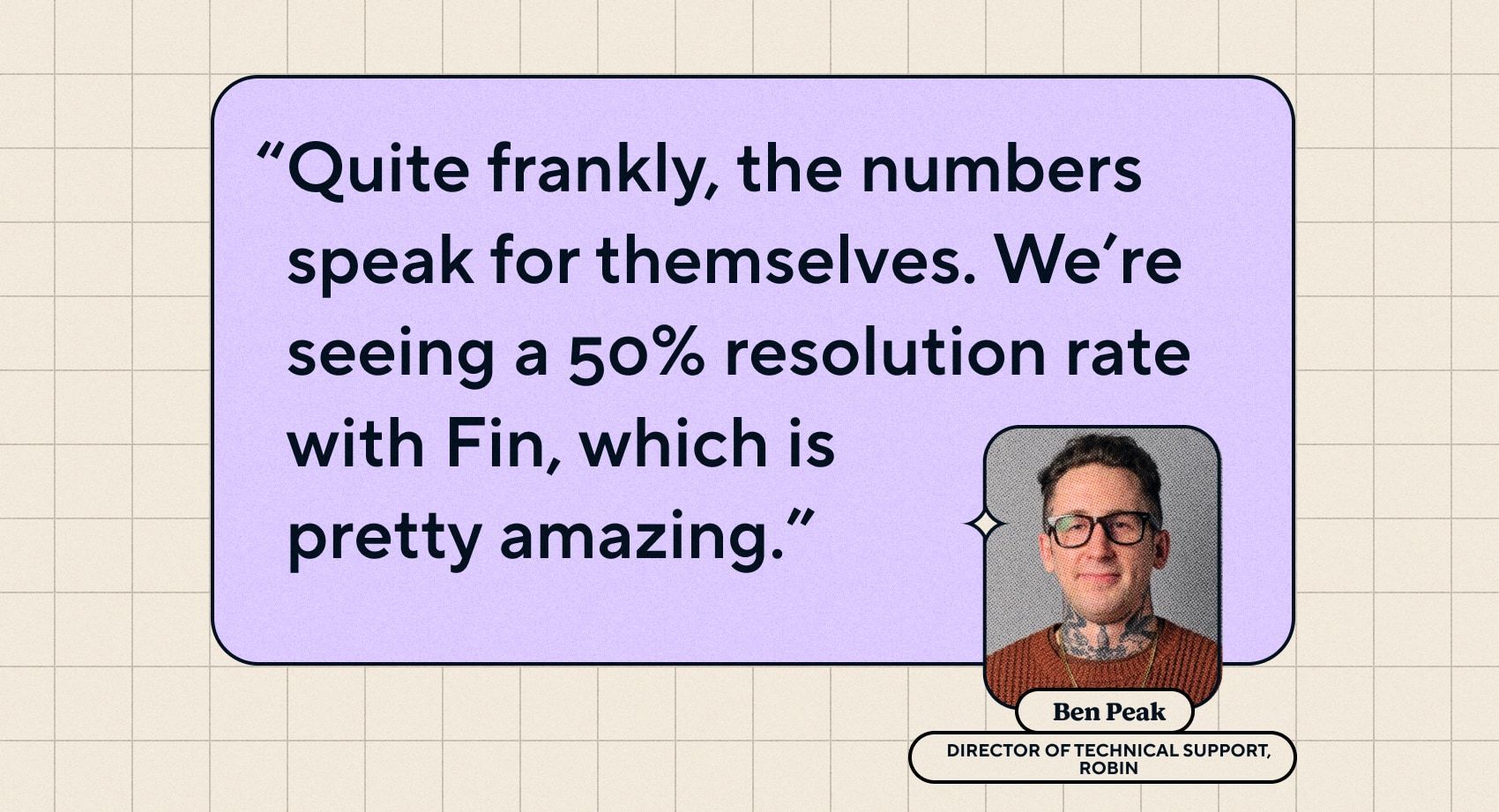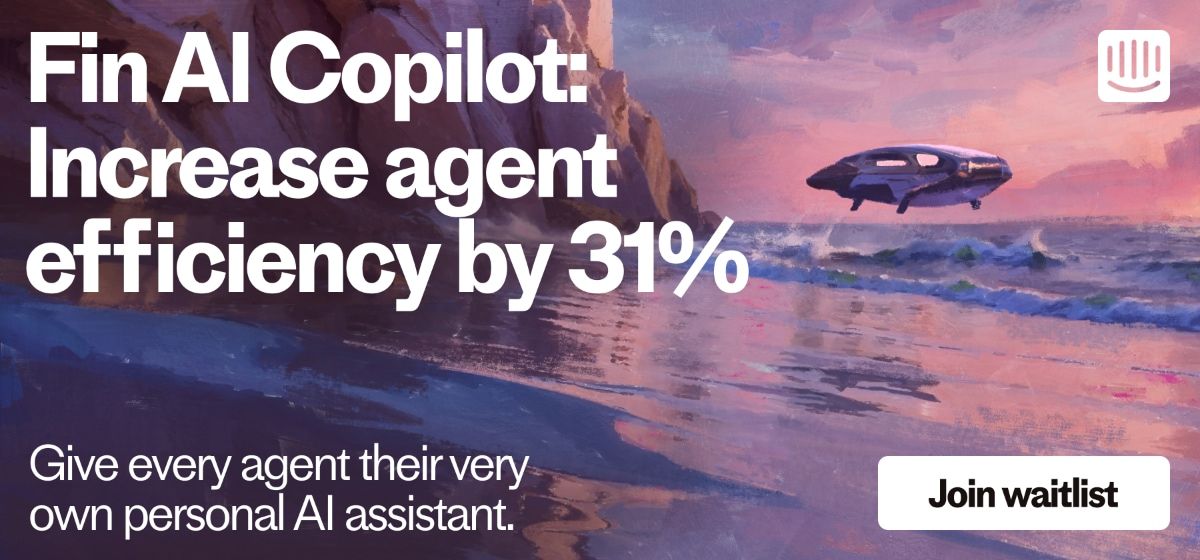
Your first 30-60-90 days using AI for customer service
If you’re still the person thinking, “I’ll just wait and see how all of this AI stuff plays out,” it’s time to reconsider. AI is not going away. It’s not a fad.
The entire customer service industry is talking about this. Your customers are expecting it: 87% of support teams have seen an increase in their customers’ expectations over the last year, and 68% believe that expectations have been directly influenced by AI.
My advice? Just get started. Here’s the how, where, and when of rolling out AI for customer support in the first 30, 60, and 90 days (along with lessons we’ve learned at Intercom 👀).
Days 1-30: Set up and test AI
Start with an AI chatbot
First, set up an AI chatbot as a gateway to AI. Most businesses are already using some sort of chat. It’s an effective and easy way to introduce AI into the customer experience.
For example, trialing Intercom’s AI chatbot Fin is a great way to get started. Using the most sophisticated AI language models, Fin automatically solves customer issues with safe, accurate, conversational answers based solely on your support content.

Trial AI with a small, trusted segment of customers
Pick a small, low-risk segment of customers to test your AI chatbot with. Most companies, especially in the B2B space, have a customer cohort of people who will be more amenable – maybe even excited – to try new things.
“We first tested AI with our early stage, startup customers”
At Intercom, we first tested AI with our early stage, startup customers. We knew that these were tech savvy customers who wouldn’t be scared to see AI popping up and asking them questions. That gave us some breathing room and goodwill as we tested answer qualities and found out what knowledge gaps we needed to fill.
Feed AI with the knowledge it needs
As our VP of Customer Support, Declan Ivory, says, “You must feed the AI beast with the knowledge it needs.” Start small and feed it with the help content you already have. If you’re using an AI chatbot, like Intercom’s Fin, you’ll be able to pull from multiple sources, including your help center content, PDFs, your internal knowledge (like Notion, Google Docs, or your internal Wiki).
Even if you start with a low resolution rate at first, you’ll quickly be able to see where AI is answering customers’ questions versus where you have knowledge management gaps. Armed with these insights, you can make improvements in the next phase. 👇
Days 31-60: Beef up your knowledge base content
Fill in content gaps with your product team
By now, you’ll know where your chatbot is able to successfully resolve customer queries versus where it’s getting stuck. From there, you can create a plan to beef up your help content.
“We worked with teammates on the product team to review relevant help articles and identify content gaps”
When we first rolled out our AI chatbot at Intercom, we had buy-in from the entire company. We worked with teammates on the product team to review relevant help articles and identify content gaps. After the first 30 days, we were able to go back to those teams again and say, “Hey, we’re getting a lot of these types of questions. Fin is failing on these topics or on this part of the product area.” Then, they quickly jumped in and helped us add missing content.
Optimize your knowledge content for compounding returns
It’s worth going through your knowledge base content line by line. That may feel like a lot (we’re all strapped for time everywhere, especially in support). But the return on that investment is absolutely worth it because it’s going to give you compounding impact. The time you put in now will add up to all of these cases that your team don’t have to handle down the road, that you and your leadership team don’t have to manage. Big bonus: it will give your team breathing space to focus on solving more complex issues.
Days 61-90: Add AI value at every touchpoint
Don’t be afraid to pivot
Don’t be afraid to experiment and make changes as you learn new lessons. For example, at Intercom, we created a big triage flow where any questions Fin couldn’t answer, it would pass to a human. We thought this was going to be really valuable. In reality, it was a little cumbersome for customers. And it wasn’t adding much value to the support rep who was getting assigned that conversation. So we changed the flow to better serve customers and the team and it’s starting to work much better for everyone now.
Add AI efficiencies throughout the customer journey
Once your AI chatbot is fine-tuned and performing well, look at the rest of the customer journey and identify where AI can add further value. For example, consider how AI can make your team more efficient, make their lives easier, and help resolve customer queries faster.
A lot of companies have some version of AI in the inbox. When we rolled out “Fin in the inbox” in the first 90 days at Intercom, we thought, “How can we get our teammates using our AI inbox features more frequently?” Whether that’s summarizing a conversation or summing up a ticket when it’s being passed over, using AI in the backend can save teammates the hassle of scrolling all the way back up a conversation, rereading everything, and manually writing a message.
The future of customer service is humans + AI
Despite all of the great progress we’ve made at Intercom, we still have plenty more to learn and explore to unlock AI’s full potential. We firmly believe the future of customer service is humans + AI and we’re going all in on making that vision a reality. We’ll share our lessons as we build, test, learn, and iterate.








